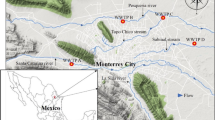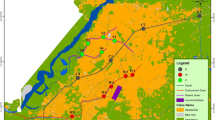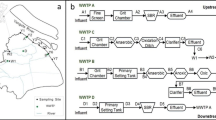Abstract
Occurrence and fate of eight kinds of selected endocrine-disrupting compounds (EDCs) in three sewage treatment plants (STPs) of Beijing, China was investigated. These EDCs, composed of 4-octylphenol (4-OP), 4-n-nonylphenol (4-n-NP), bisphenol A (BPA), estrone (E1), 17α-estradiol (17α-E2), 17β-estradiol (E2), estriol (E3) and 17α-ethinylestradiol (EE2), in every step of STPs, were simultaneously analysed by gas chromatography/mass spectrometry after derivatisation. All the EDCs were detected in the influents of three STPs, and BPA was the most abundant compound. The concentrations of EDCs ranged from 36.6 ng/l of 17α-E2 (STP C) to 1342.3 ng/l of BPA (STP B) in the influent sewages and from below limits of detection of E2 and E3 (STP C) to 142.5 ng/l of E1 (STP B) in the effluent sewages. The STPs could not remove alkylphenols effectively from the aqueous phase with less than 40% reduction. BPA decreased over 90%, and steroid estrogens achieved considerable reductions from 64.8% of E2 to 94.9% of E3. Generally, biological treatment was more effective in removing alkylphenols, BPA and natural estrogens from the aqueous phase than primary treatment. However, the synthetic estrogen, EE2, was mostly removed by the primary treatment with about 63.5% reduction. It is the first time that the concentration of 17α-E2 in the sewage of China was reported in this paper. The compound might have a bearing with the waste effluents of dairy farms around urban area of Beijing.
Similar content being viewed by others
Explore related subjects
Discover the latest articles and news from researchers in related subjects, suggested using machine learning.References
Andersen, H., Siegrist, H., Halling-Sorensen, B., & Ternes, T. A. (2003). Fate of estrogens in a municipal sewage treatment plant. Environmental Science & Technology, 37(18), 4021–4026. doi:10.1021/es026192a.
Baronti, C., Curini, R., D’Ascenzo, G., Di Corcia, A., Gentili, A., & Samperi, R. (2000). Monitoring natural and synthetic estrogens at activated sludge sewage treatment plants and in a receiving river water. Environmental Science & Technology, 34(24), 5059–5066. doi:10.1021/es001359q.
Beck, J., Totsche, K. U., & Kogel-Knabner, I. (2008). A rapid and efficient determination of natural estrogens in soils by pressurised liquid extraction and gas chromatography–mass spectrometry. Chemosphere, 71(5), 954–960. doi:10.1016/j.chemosphere.2007.11.062.
Boyd, G. R., Reemtsma, H., Grimm, D. A., & Mitra, S. (2003). Pharmaceuticals and personal care products (PPCPs) in surface and treated waters of Louisiana, USA and Ontario, Canada. Science of the Total Environment, 311(1–3), 135–149.
Cargouet, M., Perdiz, D., Mouatassim-Souali, A., Tamisier-Karolak, S., & Levi, Y. (2004). Assessment of river contamination by estrogenic compounds in Paris area (France). The Science of the Total Environment, 324(1–3), 55–66. doi:10.1016/j.scitotenv.2003.10.035.
Castiglioni, S., Bagnati, R., Fanelli, R., Pomati, F., Calamari, D., & Zuccato, E. (2006). Removal of pharmaceuticals in sewage treatment plants in Italy. Environmental Science & Technology, 40(1), 357–363. doi:10.1021/es050991m.
Desbrow, C., Routledge, E. J., Brighty, G. C., Sumpter, J. P., & Waldock, M. (1998). Identification of estrogenic chemicals in STW effluent. 1. Chemical fractionation and in vitro biological screening. Environmental Science & Technology, 32(11), 1549–1558. doi:10.1021/es9707973.
Du, B., Zhang, P., Zhang, Z., & Yu, G. (2004). Preliminary investigation on endocrine disrupting chemicals in a sewage treatment plant of Beijing. Environmental Sciences (Tokyo), 25(1), 114–116 (in Chinese).
Erb, R., Chew, B., & Keller, H. (1977). Relative concentrations of estrogen and progesterone in milk and bold, and excretion of estrogen in urine. Journal of Animal Science, 46, 617–626.
Gatidou, G., Thomaidis, N. S., Stasinakis, A. S., & Lekkas, T. D. (2007). Simultaneous determination of the endocrine disrupting compounds nonylphenol, nonylphenol ethoxylates, triclosan and bisphenol A in wastewater and sewage sludge by gas chromatography–mass spectrometry. Journal of Chromatography A, 1138(1–2), 32–41. doi:10.1016/j.chroma.2006.10.037.
Hanselman, T., Graetz, D., & Wilkie, A. (2003). Manure-borne estrogens as potential environmental contaminants: A review. Environmental Science & Technology, 37, 5471–5478. doi:10.1021/es034410+.
Hernando, M. D., Mezcua, M., Gomez, M. J., Malato, O., Aguera, A., & Fernandez-Alba, A. R. (2004). Comparative study of analytical methods involving gas chromatography–mass spectrometry after derivatization and gas chromatography–tandem mass spectrometry for the determination of selected endocrine disrupting compounds in wastewaters. Journal of Chromatography A, 1047(1), 129–135. doi:10.1016/j.chroma.2004.06.123.
Hesselsoe, M., Jensen, D., & Skals, K. (2000). Degradation of 4-nonyphenol in homogeneous and nonhomogeneous mixtures of soil and sewage sludge. Environmental Science & Technology, 35(18), 3695–3700. doi:10.1021/es010024l.
Jin, S., Xu, Y., Hui, Y., & Liao, T. (2005). Quantitative determination of eight kinds of estrogenic compounds in wastewater. China Water and Wastewater, 21(12), 94–97 (in Chinese).
Johnson, A. C., Aerni, H.-R., Gerritsen, A., Gibert, M., Giger, W., Hylland, K., et al. (2005). Comparing steroid estrogen, and nonylphenol content across a range of European sewage plants with different treatment and management practices. Water Research, 39(1), 47–58. doi:10.1016/j.watres.2004.07.025.
Johnson, A. C., & Sumpter, J. P. (2001). Removal of endocrine-disrupting chemicals in activated sludge treatment works. Environmental Science & Technology, 35(24), 4697–4703. doi:10.1021/es010171j.
Kanda, R., Griffin, P., James, H. A., & Fothergill, J. (2003). Pharmaceutical and personal care products in sewage treatment works. Journal of Environmental Monitoring, 5(5), 823–830. doi:10.1039/b306355k.
Kavlock, R. J. (1999). Overview of endocrine disruptor research activity in the United States. Chemosphere, 39(8), 1227–1236. doi:10.1016/S0045-6535(99)00190-3.
Khanal, S. K., Xie, B., Thonpson, M. L., Sung, S., Ong, S.-K., & Leeuwen, J. H. V. (2006). Fate, transport, and biodegradation of natural estrogens in the environment and engineered systems. Environmental Science & Technology, 40(21), 6537–6546. doi:10.1021/es0607739.
Kolpin, D. W., Furlong, E. T., Meyer, M. T., Thurman, E. M., Zaugg, S. D., Barber, L. B., et al. (2002). Pharmaceuticals, hormones, and other organic wastewater contaminants in U.S. streams, 1999–2000: A national reconnaissance. Environmental Science & Technology, 36(6), 1202–1211. doi:10.1021/es011055j.
Korner, W., Bolz, U., Sußmuth, W., Hiller, G., Schuller, W., Hanf, V., et al. (2000). Input/output balance of estrogenic active compounds in a major municipal sewage plant in Germany. Chemosphere, 40(9–11), 1131–1142. doi:10.1016/S0045-6535(99)00362-8.
Lagana, A., Bacaloni, A., De Leva, I., Faberi, A., Fago, G., & Marino, A. (2004). Analytical methodologies for determining the occurrence of endocrine disrupting chemicals in sewage treatment plants and natural waters. Analytica Chimica Acta, 501(1), 79–88. doi:10.1016/j.aca.2003.09.020.
Mol, H. G. J., Sunarto, S., & Steijger, O. M. (2000). Determination of endocrine disruptors in water after derivatization with N-methyl-N-(tert.-butyldimethyltrifluoroacetamide) using gas chromatography with mass spectrometric detection. Journal of Chromatography A, 879(1), 97–112. doi:10.1016/S0021-9673(00)00124-2.
Nakada, N., Tanishima, T., Shinohara, H., Kiri, K., & Takada, H. (2006). Pharmaceutical chemicals and endocrine disrupters in municipal wastewater in Tokyo and their removal during activated sludge treatment. Water Research, 40(17), 3297–3303. doi:10.1016/j.watres.2006.06.039.
Routledge, E. J., & Sumpter, J. P. (1996). Estrogenic activity of surfactants and some of their degradation products assessed using a recombinant yeast screen. Environmental Toxicology and Chemistry, 15(3), 241–248. doi:10.1897/1551-5028(1996)015<0241:EAOSAS>2.3.CO;2.
Routledge, E. J., Sheahan, D., Desbrow, C., Brighty, G. C., Waldock, M., & Sumpter, J. P. (1998). Identification of estrogenic chemicals in STW effluent. 2. In vivo responses in trout and roach. Environmental Science & Technology, 32(11), 1559–1565. doi:10.1021/es970796a.
Sakamoto, M., Zhang, H., Yamada, H., & Tsuno, H. (2006). Behavior of estrogenic compounds in advanced sewage treatment processes. Paper presented at the 12th seminar of JSPS-MOE Core University Program on urban environment, Kyoto, Japan.
Sarmah, A. K., Northcott, G. L., Leusch, F. D. L., & Tremblay, L. A. (2006). A survey of endocrine disrupting chemicals (EDCs) in municipal sewage and animal waste effluents in the Waikato region of New Zealand. The Science of the Total Environment, 355(1–3), 135–144. doi:10.1016/j.scitotenv.2005.02.027.
Servos, M. R., Bennie, D. T., Burnison, B. K., Jurkovic, A., McInnis, R., Neheli, T., et al. (2005). Distribution of estrogens, 17[beta]-estradiol and estrone, in Canadian municipal wastewater treatment plants. The Science of the Total Environment, 336(1–3), 155–170. doi:10.1016/j.scitotenv.2004.05.025.
Shareef, A., Angove, M. J., & Wells, J. D. (2006). Optimization of silylation using N-methyl-N-(trimethylsilyl)-trifluoroacetamide, N,O-bis-(trimethylsilyl)-trifluoroacetamide and N-(tert-butyldimethylsilyl)-N-methyltrifluoroacetamide for the determination of the estrogens estrone and 17[alpha]-ethinylestradiol by gas chromatography–mass spectrometry. Journal of Chromatography A, 1108(1), 121–128. doi:10.1016/j.chroma.2005.12.098.
Tauxe-Wuersch, A., De Alencastro, L. F., Grandjean, D., & Tarradellas, J. (2005). Occurrence of several acidic drugs in sewage treatment plants in Switzerland and risk assessment. Water Research, 39(9), 1761–1772. doi:10.1016/j.watres.2005.03.003.
Ternes, T. A. (1998). Occurrence of drugs in German sewage treatment plants and rivers. Water Research, 32(11), 3245–3260. doi:10.1016/S0043-1354(98)00099-2.
Ternes, T. A., Stumpf, M., Mueller, J., Haberer, K., Wilken, R.-D., & Servos, M. (1999). Behavior and occurrence of estrogens in municipal sewage treatment plants—I. Investigations in Germany, Canada and Brazil. The Science of the Total Environment, 225(1–2), 81–90. doi:10.1016/S0048-9697(98)00334-9.
Vieno, N. M., Tuhkanen, T., & Kronberg, L. (2005). Seasonal variation in the occurrence of pharmaceuticals in effluents from a sewage treatment plant and in the recipient water. Environmental Science & Technology, 39(21), 8220–8226. doi:10.1021/es051124k.
Yang, J. J., & Metcalfe, C. D. (2006). Fate of synthetic musks in a domestic wastewater treatment plant and in an agricultural field amended with biosolids. The Science of the Total Environment, 363(1–3), 149–165. doi:10.1016/j.scitotenv.2005.06.022.
Ying, G. G., Kookana, R. S., & Ru, Y. J. (2002a). Occurrence and fate of hormone steroids in the environment. Environment International, 28(6), 545–551. doi:10.1016/S0160-4120(02)00075-2.
Ying, G. G., Williams, B., & Kookana, R. (2002b). Environmental fate of alkylphenols and alkylphenol ethoxylates—A review. Environment International, 28(3), 215–226. doi:10.1016/S0160-4120(02)00017-X.
Zhang, Z. L., Hibberd, A., & Zhou, J. L. (2006). Optimisation of derivatisation for the analysis of estrogenic compounds in water by solid-phase extraction gas chromatography–mass spectrometry. Analytica Chimica Acta, 577(1), 52–61. doi:10.1016/j.aca.2006.06.029.
Zuo, Y., & Zhang, K. (2005). Suitability of N,O-bis(trimethylsilyl)trifluoroacetamide as derivatization reagent for the determination of the estrogens estrone and 17 [alpha]-ethinylestradiol by gas chromatography-mass spectrometry. Journal of Chromatography A, 1095(1–2), 201–202. doi:10.1016/j.chroma.2005.08.096.
Author information
Authors and Affiliations
Corresponding author
Rights and permissions
About this article
Cite this article
Zhou, H., Huang, X., Wang, X. et al. Behaviour of selected endocrine-disrupting chemicals in three sewage treatment plants of Beijing, China. Environ Monit Assess 161, 107–121 (2010). https://doi.org/10.1007/s10661-008-0731-6
Received:
Accepted:
Published:
Issue Date:
DOI: https://doi.org/10.1007/s10661-008-0731-6




